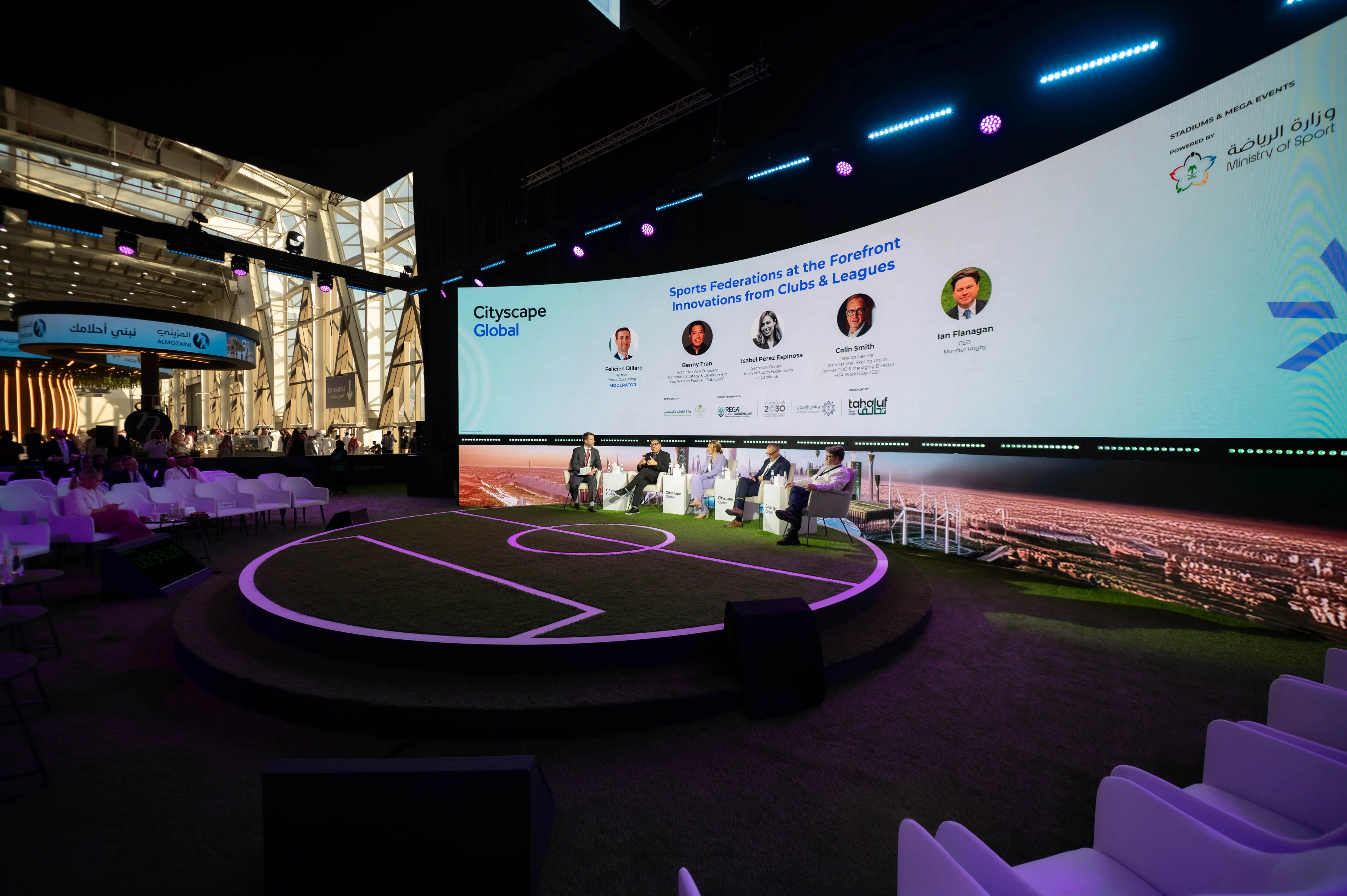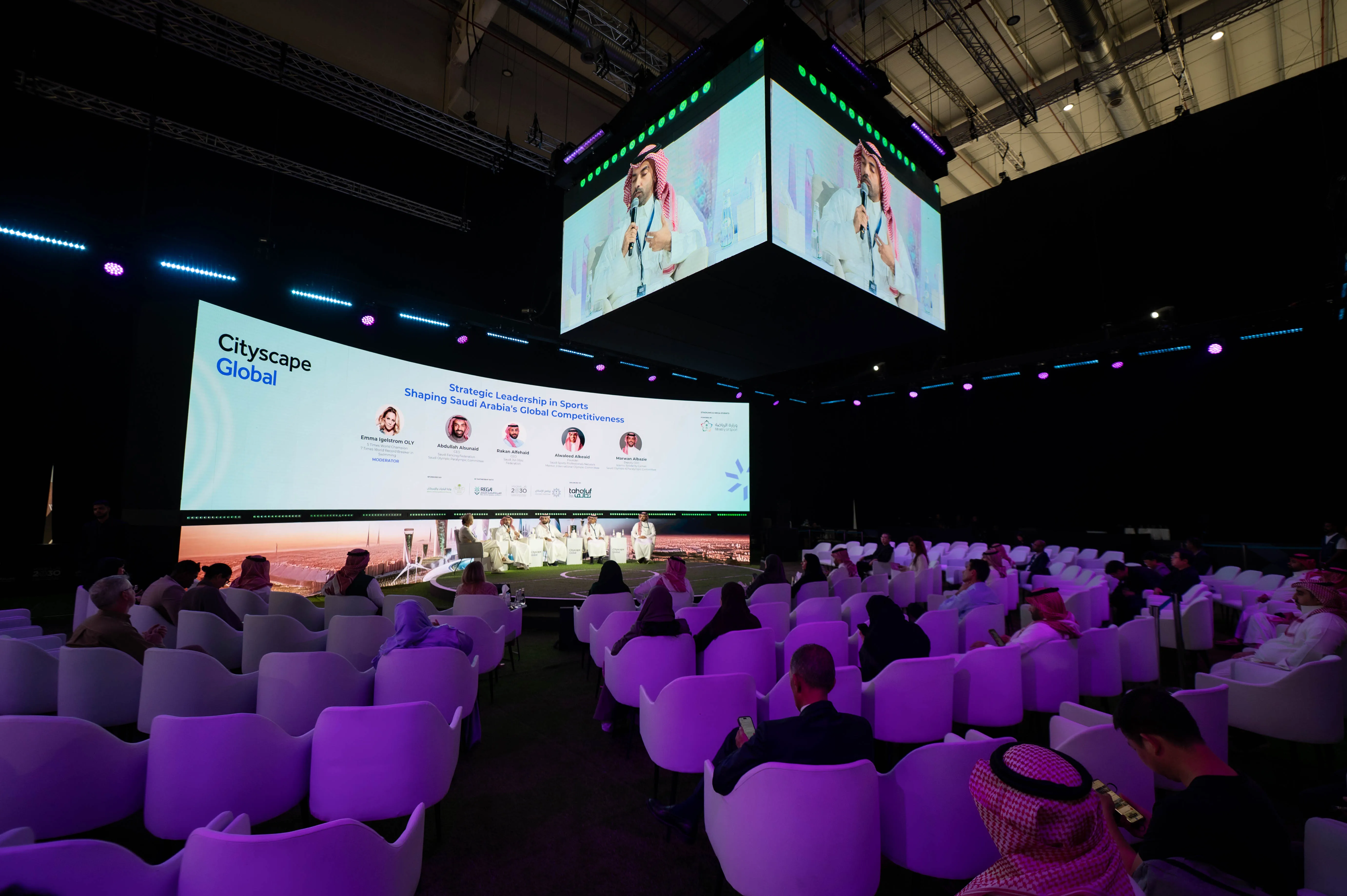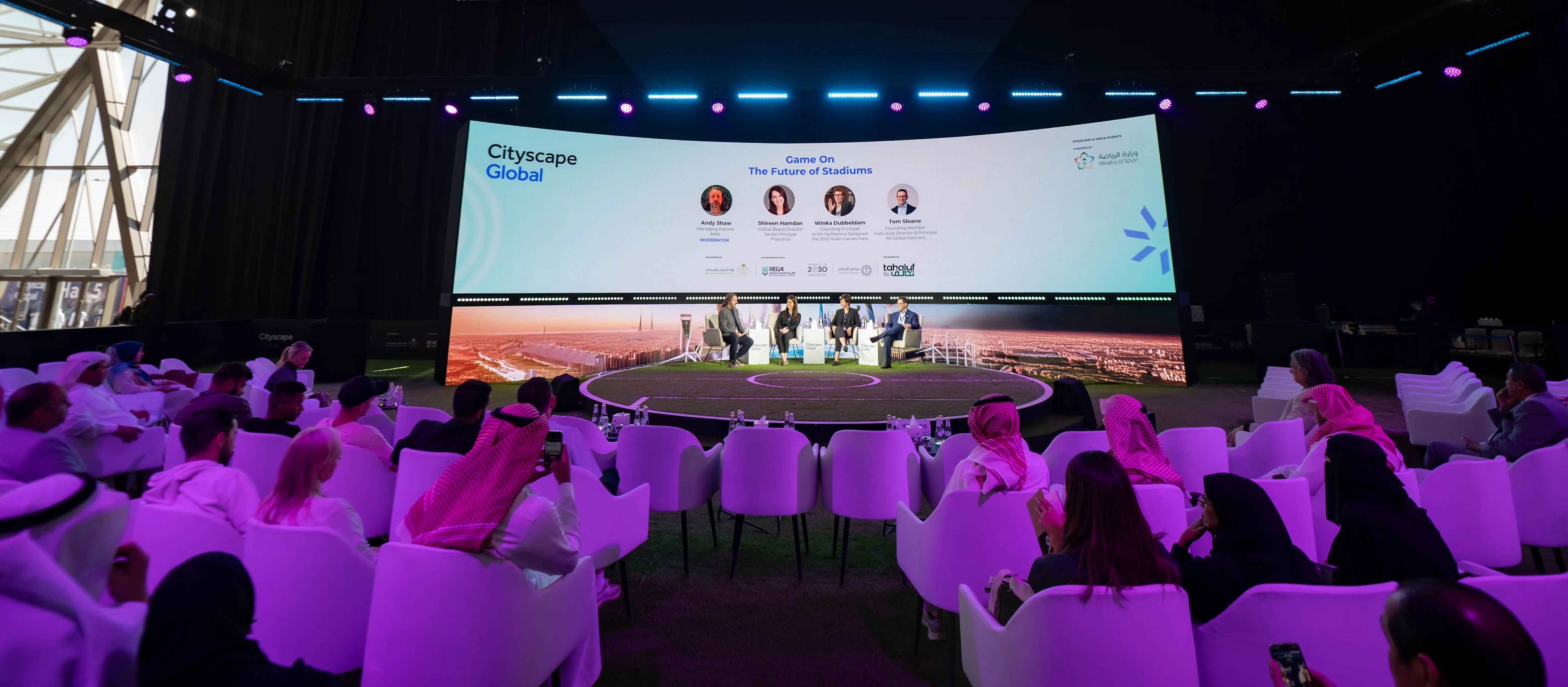From community rugby grounds to futuristic, multi-use mega-stadiums, sports venues are transforming on a global scale. At Cityscape Global 2025, leaders from across the sports ecosystem, from diverse geographies –including Europe, the USA, and the Middle East gathered to explore the innovations redefining stadium infrastructure, fan engagement, and sustainable growth.
How Sports Federations, Clubs, and Leagues Are Future-Proofing Venues and Fan Experiences

Global Governance and Mega-Event Planning
Colin Smith, Director General of the International Skating Union and former COO and Managing Director of the FIFA World Cup 2022, provided insight into what international rights holders prioritise when selecting host cities. “It’s not just about stadium specs,” he said. “It’s about the story–how the venue fits into national goals like Saudi Arabia’s Vision 2030 or what legacy it leaves.”
He cited how hosting models have evolved, with US venues like Dallas and Atlanta maximising daily commercial use, while newly built stadiums (like those in Qatar 2022) risk underutilisation post-event. The key? Tailoring the venue to local needs while integrating innovation meaningfully, not overloading it with “everything” and losing focus.
From Grassroots to Global: Challenges and Creative Solutions in Sports Venue Development
Isabel Pérez, Secretary General of the Union of Sports Federations of Catalonia (UFEC), opened the session with a candid look at grassroots sports in Spain. UFEC oversees 71 sports federations, 12,000 clubs, and over 850,000 licensed athletes. Accounting for 10% of Catalonia’s population and yet the region faces a critical shortage of sports facilities.
“We're not solving the infrastructure problem,” Isabel said. “We’re being creative. We use schools, natural environments, even streets to ensure people can play sport.”
This approach contrasts with elite venues that struggle with the inverse problem: having space, but not enough year-round use. This dichotomy became a central theme throughout the panel.
Stadiums as Community Assets: A Rugby Perspective
Ian Flanagan, CEO of Munster Rugby, presented the storied Thomond Park as a model of deep-rooted community engagement. Despite undergoing a major refurbishment in 2008, the stadium remains accessible and grounded in tradition.
“In Ireland, we don’t do premium hospitality like elsewhere,” Ian explained. “We’ve kept standing terraces to preserve affordability and atmosphere. Supporters arrive three hours early to claim their usual spot.”
This sentiment of ownership extends beyond spectators. On match days, children from local rugby clubs participate in mini-tournaments on the pitch, creating a tangible link between grassroots and professional players. While the club limits non-rugby events to protect the turf, it actively hosts school finals and community games, building loyalty that lasts generations.
Even Munster’s light shows are participatory. Instead of imposing spectacle, the club invited fans to download an app that controlled their phone’s flashlight, creating an interactive light display when teams entered the pitch.
Designing for Diversity: LAFC’s Commercial and Cultural Strategy
Benny Tran, Executive Vice President of Corporate Strategy and Development at Los Angeles Football Club (LAFC), highlighted a distinct challenge: standing out in a highly competitive entertainment market like Los Angeles, which is home to 12 professional teams and 10 stadiums.
“Our strategy from day one was to build a community asset,” he said. “It wasn’t just about sport–it was about uniting the city and being a force for good.”
From design sessions with fans to installing removable seating for concerts, LAFC built flexibility into its DNA. The club now hosts over 150 private events annually, 24 concert nights, and multiple tenants, including Angel City FC. State-of-the-art infrastructure, like one Wi-Fi access point per 60 seats and NFC ticketing, ensures a seamless fan experience.
But cultural sensitivity remains key. “We created rituals, not mascots,” Benny explained. “Like a falcon instead of cheerleaders. We’re blending American entertainment with European football culture.”
The Community-Centric vs. Commercial Approach
This theme of duality continued as the panel compared strategies: Munster’s choice to limit concerts in favour of community events contrasts with Real Madrid’s Santiago Bernabéu. The latter’s ultra-innovative transformation now allows for rapid conversion between pitch and stage, but it came at a cost. An intense summer concert schedule led to traffic, noise, and cleanliness issues, prompting backlash from residents.
“Great innovation can fail if it forgets the community around it,” Isabel noted.
Technology: Additive or Intrusive?
The session also examined how technology enhances (or detracts from) fan engagement. LAFC’s big screens display stats, sponsor content, and cinematic visuals for events like the Riyadh Series boxing matches. But European clubs remain cautious. “We’re not imposing jumbotrons,” Ian clarified. “Our fans don’t want another big screen–they want connection.”
Even innovations like Apple Pay, Amazon Go-style food kiosks, and LED show integration are designed to reduce friction without overwhelming traditionalists.
Sustainability: From Regulation to Consciousness
As sustainability becomes non-negotiable in venue design, the panel explored approaches across continents. LAFC achieved LEED Gold certification by planting desert flora and using oil-free chillers. In Lausanne, the Vaudoise Aréna utilises excess energy from its ice rink to heat its swimming pool, creating a perfect closed-loop system.
But Isabel offered a compelling point, sports isn’t just a consumer of sustainable tech—it’s a communicator. “Sports has a privileged voice. We can bring the message of sustainability into every home.”
UFEC now leads EU-funded programmes to help organisers run greener events—and fans, especially younger ones, are increasingly conscious. “Even a $1 tree donation on a ticket matters,” Benny said.
One Message, Many Models
The panel concluded with a clear takeaway: while the methods differ, the mission remains the same —to build smarter, serve communities better, and embrace innovation with purpose.
As global conversations around sports infrastructure continue to evolve, platforms that bring together these diverse perspectives are more important than ever. That’s precisely what ESTAAD, co-located with Cityscape Global 2025, sets out to do.
By showcasing how sport is reshaping cities, economies, and communities, ESTAAD provides a unique platform for collaboration across sectors—from federations and clubs to investors, architects, and policymakers. It’s where ideas meet action, and where the future of sports infrastructure is shaped through collaborative efforts.
If you're interested in the future of sports, venue development, or urban transformation, ESTAAD is a place you won’t want to miss.

